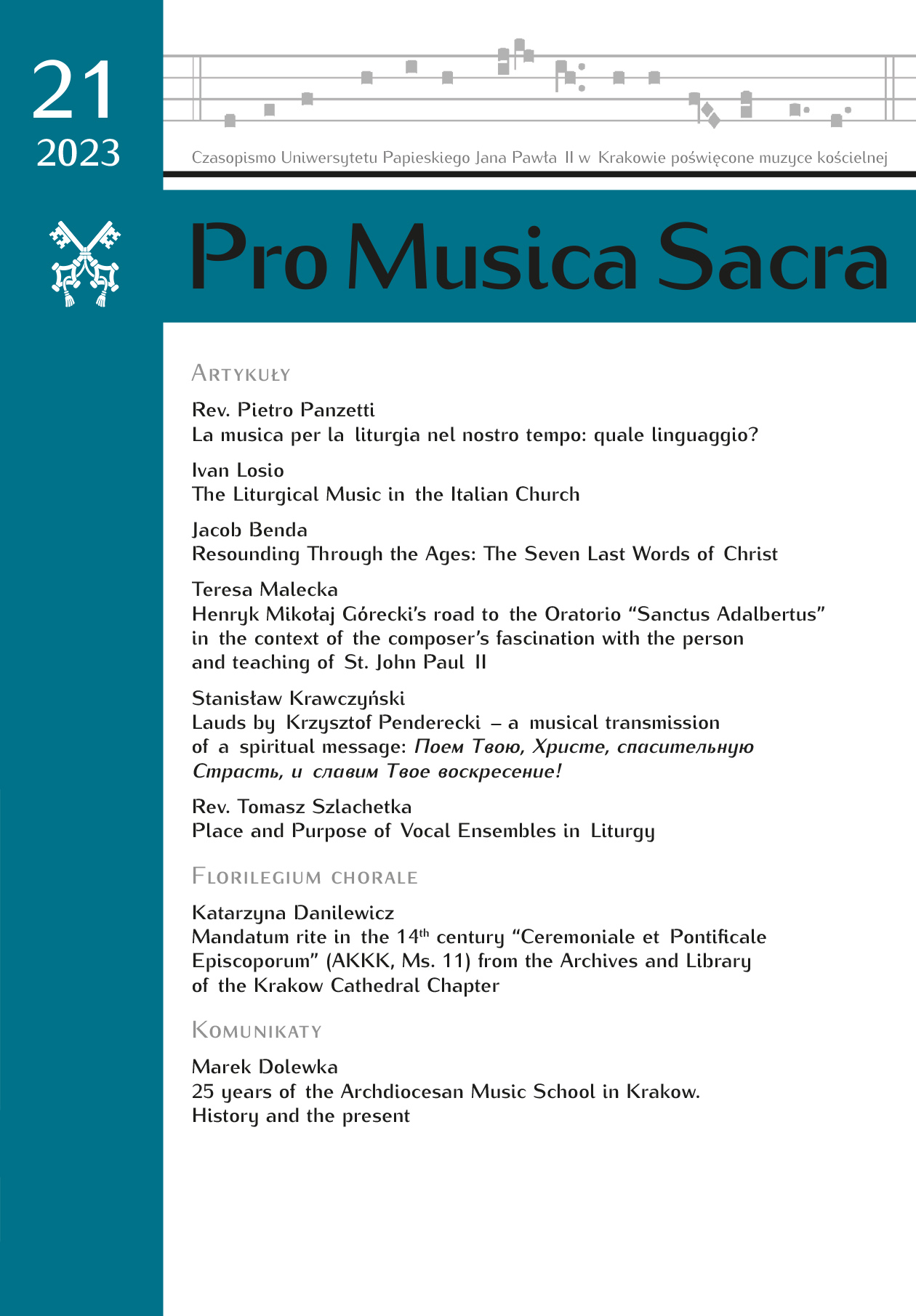Henryk Mikołaj Górecki’s road to the Oratorio “Sanctus Adalbertus” in the context of the composer’s fascination with the person and teaching of St. John Paul II
DOI:
https://doi.org/10.15633/pms.2104Słowa kluczowe:
Górecki, John Paul II, Saint Adalbert, oratorio, BogurodzicaAbstrakt
Henryk Mikołaj Górecki’s profound personal religiousnessbecame the source of his deep spiritual bond with the personality of Karol Wojtyła – Saint John Paul II. The relationship between the composer and the Pope was of a special nature. In 1977, Cardinal Karol Wojtyła commissioned a work from Henryk Mikołaj Górecki to commemorate the 900th anniversary of the death of St Stanislaus. The result was the oratorio Beatus Vir Op. 38, a psalm for baritone, mixed choir and orchestra. Since its premiere, the composer has been urged by the Pope to compose further works of religious music. This was to be a larger cycle dedicated to Polish saints. Only the oratorio on St Adalbert was written, the fate of which was unknown during the composer’s lifetime. Its manuscript was found in materials left behind by his son. The text of Sanctus Adalbertus is laconic, building up already at the level of words a specific drama typical of the composer. It is sung in Latin alternating with Polish (there is also a Czech variant, which is understandable given St Adalbert’s nationality), and, as so often in Górecki’s work, is based on thoughts taken from the Psalms. While the first three parts of the work can be said to be composed as a whole by ‘juxtaposing’ different sound models, different idioms repeated many times in an irregular manner peculiar to Górecki, the fourth part, with its clear three-part structure, is built in a processual manner. Górecki’s Gloria is derived, as it were, from the song Bogurodzica and tends towards it. In the maximally muted ending of the work, the melody returns, this time as if a reminder of it in the single, delicate strikes of the bells and grand piano leading to the utterance of the saint’s name: “Sanctus Adalbertus”. The work can be interpreted as a journey towards the quotation from the oldest Polish hymn – Bogurodzica (Mother of God), as a journey to the source – to the roots of a Polish national identity in times of rebirth.
Bibliografia
Birkenmajer J., Zagadnienie autorstwa „Bogurodzicy”, Gniezno 1935 (Studia Gnesnen sia, 11).
“Composing is a Terribly Personal Matter"” Henryk Mikołaj Górecki in Conversation with Maja Trochimczyk, transl. M. Trochimczyk, in: Górecki in Context. Essays on Music, ed. by M. Trochimczyk, Moonrise Press, Los Angeles 2017, p. 45–66 (Books on Music, 2).
Górecki H. M., Wystąpienie Doktora honoris causa Akademii Muzycznej w Krakowie, „Teoria Muzyki. Studia, Interpretacje, Dokumentacje” (2013) nr 3, p. 103–118.
Jan Paweł II, Encyklika Redemptoris Mater, Rzym 1987.
Jan Paweł II, Piękno. Antologia tekstów, red. D. Radziechowski, słowo wstępne J. Kup czak OP, Wydawnictwo Uniwersytetu Ekonomicznego, Kraków 2008.
John Paul II, O Lord… deliver me!, General audience, 26.01.2005, https://www.vatican.va/content/john-paul-ii/en/audiences/2005/documents/hf_jp-ii_aud_20050126.html (27.06.2023).
Kiwała K., Problematyka sacrum w polskiej muzyce współczesnej na przykładzie utworów związanych z osobą Ojca Świętego Jana Pawła II, Kraków 2002, mps.
Muzyka jest rozmową, prof. Henryk Mikołaj Górecki w rozmowie z A. Wieczorek i K. Cy ranem, „Jubinalia” (2008) nr 4, s. 1–7.
Sacrum i profanum w muzyce, z prof. M. Tomaszewskim rozmawia M. Janicka-Słysz, „Masz karon” styczeń, luty, marzec 2000, p. 30.
Wokół ostatnich dzieł Henryka Mikołaja Góreckiego. Styl późny a styl ostatni, in: Styl późny w muzyce, literaturze i kulturze, vol. 4, Katowice 2016, p. 172–187.
Pobrania
Opublikowane
Numer
Dział
Licencja

Utwór dostępny jest na licencji Creative Commons Uznanie autorstwa 4.0 Międzynarodowe.
Autorzy publikujący w czasopiśmie udzielają jego wydawcy zgody o następującej treści:
- Autor zachowuje autorskie prawa majątkowe do utworu, a jednocześnie udziela wydawcy czasopisma zgody na jego pierwszą publikację w wersji drukowanej i wersji online na licencji Creative Commons Uznanie autorstwa 4.0 Międzynarodowe oraz zgody na wykonywanie opracowań, w tym przekładów.
- Autor ma możliwość udzielania zgody niewyłącznej na opublikowanie utworu w wersji, która ukazała się w czasopiśmie (np. zamieszczenia go w repozytorium instytucjonalnym lub opublikowania w książce), wraz z informacją o jego pierwszej publikacji w czasopiśmie.
- Autor może umieścić swój utwór online (np. w repozytorium instytucjonalnym lub na swojej stronie internetowej) jeszcze przed zgłoszeniem utworu do czasopisma.

